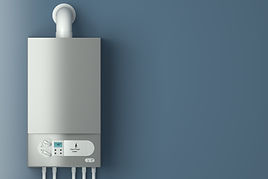Cooling, Heating & Renewable Systems
Heating and cooling is one of the biggest energy uses, particularly in Canada where a long winter is typically followed by several months of hot summer weather resulting in high heating and cooling loads around the year. Both heating and cooling systems are typically centrally controlled though some houses and multi-unit residences can have individual controls for the settings. Without adequate maintenance and upgrades, there are immense losses associated with heating and cooling and therefore, while considering retrofits, it is essential to consider your heating and cooling systems as well.
In addition, the other important part of the equation is the source of your energy. As our world increasingly begins to see the adverse impacts of climate change, there is a shift in our perspective. We want energy efficiency but we will inevitably need energy, no matter how much we reduce our usage by increasing efficiency. Thus, it is important to ensure that our energy sources are sustainable. This is the right time to start thinking about installing renewable system in your homes and buildings. Not only are there rebates associated with renewable projects, as well as grants, using renewable energy will pay you back in the long term by enabling you to keep your home independent and eco-friendly and even potentially, earning you back money by contributing to your community.
Factors That Affect Your Heating and Cooling
There are several factors that impact the type of heating and cooling system you need, which are outlined below:
-
Outdoor Heat and Humidity: The cooler it is outside, the longer it will take to heat your home and vice versa.
-
Home Size: The larger your home, the greater its cooling load and vice versa.
-
Insulation: Homes with the right amount of insulation can resist outdoor heat better.
-
Air Conditioner Size: Units with smaller cooling capacities can cool rooms slower than those with larger capacities.
-
Air Leaks: The more air leaks there are in your home, the more time it will take to cool.

23°
Using smart thermostats can save you up to 23% on heating and cooling bills
TYPES OF COOLING, HEATING & RENEWABLE RETROFITS
Find out more about the different cooling and heating systems, by clicking below.


Annual heating and cooling energy demand decreases up to 16%
when changing window insulation in a poorly insulated house
Types of Heating and Cooling Systems
Furnaces
Furnaces are the most commonly used residential heating system which means that they are in each of our houses. They run most often on gas, but sometimes on oil, propane, or electricity, delivering heat through a system of ducts. Furnaces with energy efficiency over 90 percent can transfer heat through water or condensate, which is a byproduct of combustion. Your furnace is most typically located either on the ground floor or the basement so be sure to go check it out to see what your energy efficiency ratio is. A lot of the older models are being upgraded by companies for a minimum fee so take advantage of that system. Be sure to not touch any surfaces since they can be unexpectedly hot. Another feature of efficient furnaces is a highly efficient blower motor (commonly an ECM, Electronically Commutated Motor, or another type of “advanced main air circulating fan”). Whether you’re checking your current furnace or planning to buy a new one, keep this tidbit in mind to confirm you’re getting the maximum benefit.
Examples of furnaces, older and more modern furnaces may look slightly different in design and size.
Image obtained from: Enersure, click on image for reference

A gas-fired boiler
Image obtained from: Wix
Boiler
A boiler heats your home by burning gas, propane, or oil to heat water or steam that circulates through radiators, baseboards, or radiant floor systems, which are also discussed in the major retrofits, here. Features that improve boiler efficiency include electronic ignition, which eliminates the need to have the pilot light burning all the time, essentially behaving like a programmable thermostat but specifically for your boiler. Additionally, there are newer technologies that extract more heat from the same amount of fuel and these are being constantly upgraded as well.
Central Air Conditioners
Most residential central air conditioners are called “split-systems” because they have an outdoor component with a condenser and compressor and an indoor component with an evaporator coil. It’s very important to replace both of these units at the same time, so you aren’t limited by the efficiency of one. Installing a new outdoor unit without replacing the indoor unit is likely to result in low efficiency, and may lead to premature failure of the system. When changing the central air conditioner, it also needs a blower motor—which is usually part of the furnace—to blow the cool air through the duct system. The only way to ensure that your new air conditioner performs at its rated efficiency, is to replace your heating system at the same time. So when you’re planning your next retrofit, keep this in mind and upgrade both systems simultaneously for maximum benefit.

A standing AC on the outside of a home
Image obtained from: Wix
It is not just important to choose the right heating and cooling system but also ensure it is properly installed. Always use a certified building specialist or contractor for this to minimize any mistakes that will drive up your energy bills.
